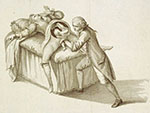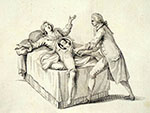| Catalogue > Glossary > |
Presentation of the fetus
. . . . . . . . . . . . . . . . .
The term presentation applies to the first large fetal part to make contact with the superior pelvic strait.
|
| |
Cephalic presentation: face first
Occurs when the fetus engages face-first in the superior strait. In the past, attempts were made to rotate the fetus manually into a breech presentation or a vertex presentation. François Mauriceu (1637-1709) believed that the face-first presentation should be transformed into a vertex presentation by introducing the hand into the birth canal; William Smellie (1697-1783) regarded this presentation as an anomaly. Lorenzo Nannoni (1749-1812), in his Trattato di ostetricia (1785), stated that the face-first delivery was normal. However, fetal mortality was 15-20% in 1870 and there were risks of ecchymosis and phlogosis (bruising and inflammation) to the eyeballs, and of swelling at birth.
|
Cephalic presentation: forehead first
This presentation was first discussed by François Mauriceau (1637-1709) in a work of 1668 and later by William Smellie (1697-1783). The first to describe it correctly was Madame La Chapelle (1769-1821), head of the Paris Maternity Hospital from 1797 to 1821, in her Pratiques des accouchements (1821). For several decades, the forehead-first cephalic presentation was ignored by gynecologists, until the fundamental study by Luigi Mangiagalli (1849-1928), Il parto per il fronte (1880).
|
Cephalic presentation: vertex or occipital
Delivery is normal or physiological when the fetus is in a vertex or occipital presentation (90-95% of the time). Cephalic presentation can also be deflected (c. 1.3% of the time) in the brow (bregma), forehead, and face variants.
|
 Shoulder presentation
Shoulder presentation
In the transverse presentation the fetus lies horizontally, its back facing up or down. This type of situation is rather rare (2%) and occurs more often in multiple births because of tone loss in the uterine-abdominal walls, which prevents the fetus from shifting to a longitudinal position. A complication associated with this type of birth is the prolapsus of the umbilical cord: in transverse presentations, the umbilicus (navel) is near the uterine orifice and the presented part is high. The first cases described with certainty date from the early twentieth century. Today, Cesarean section is the prescribed procedure for this presentation.
|
 Breech presentation
Breech presentation
Breech presentation occurs when the part presented at the pelvic entrance lies caudally with respect to the iliac crests of the fetus, i.e., the buttocks and both feet (complete breech) or only the buttocks or one or more parts of the inferior limbs (incomplete breech: buttocks, knees or foot first).
Hippocrates (c. 460-370 B.C.E.), Pliny (c. 23-79) and Celsus (1st C.) regarded a fetus in breech presentation as impossible to deliver. In antiquity, breech-born children were called agrippi, meaning "delivered with difficulty" (aegre parti). Agrippa and Nero were said to have been born in this way. Until the time of Ambroise Paré (late sixteenth century), physicians were advised to position the head facing down and turn the presentation into a cephalic presentation. This procedure caused massive mortality. In the early nineteenth century, Francesco Asdrubali (1756-1832) noted that the causes of the extremely high mortality rate included the extraction of the head and fetal asphyxia. Breech presentations account for c. 3.6% of deliveries: buttocks present first in two-thirds of cases, knees and feet first in the remaining third.
|
................................. |
| |
|
| |
|
EXPLORE...
related objects
-
 XVIII.10 Model of pregnancy at about week 16
XVIII.10 Model of pregnancy at about week 16
-
 XVIII.11 Model of pregnancy at start of third trimester
XVIII.11 Model of pregnancy at start of third trimester
-
 XVIII.12 Model of pregnancy in third trimester
XVIII.12 Model of pregnancy in third trimester
-
 XVIII.13 Model of pregnancy at term
XVIII.13 Model of pregnancy at term
-
 XVIII.14 Model of pregnancy at term: cephalic presentation of engagement
XVIII.14 Model of pregnancy at term: cephalic presentation of engagement
-
 XVIII.15 Model of pregnancy at term: cephalic presentation of engagement (Dep. OSMN, Firenze)
XVIII.15 Model of pregnancy at term: cephalic presentation of engagement (Dep. OSMN, Firenze)
-
 XVIII.16 Model of disengagement of the head in vertex presentation
XVIII.16 Model of disengagement of the head in vertex presentation
-
 XVIII.17 Model of disengagement of the head in vertex presentation (Dep. OSMN, Firenze)
XVIII.17 Model of disengagement of the head in vertex presentation (Dep. OSMN, Firenze)
-
 XVIII.18 Model of internal rotation in vertex presentation
XVIII.18 Model of internal rotation in vertex presentation
-
 XVIII.19 Model of pregnancy at term
XVIII.19 Model of pregnancy at term
-
 XVIII.20 Model of disengagement of the head in vertex presentation
XVIII.20 Model of disengagement of the head in vertex presentation
-
 XVIII.21 Model of placental stage
XVIII.21 Model of placental stage
-
 XVIII.23 Model of brow presentation
XVIII.23 Model of brow presentation
-
 XVIII.25 Model of forehead presentation (Dep. OSMN, Firenze)
XVIII.25 Model of forehead presentation (Dep. OSMN, Firenze)
-
 XVIII.26 Model of face presentation (Dep. OSMN, Firenze)
XVIII.26 Model of face presentation (Dep. OSMN, Firenze)
-
 XVIII.27 Model of face presentation
XVIII.27 Model of face presentation
-
 XVIII.28 Model of face presentation
XVIII.28 Model of face presentation
-
 XVIII.29 Model of incomplete breech presentation (Dep. OSMN, Firenze)
XVIII.29 Model of incomplete breech presentation (Dep. OSMN, Firenze)
-
 XVIII.30 Model of incomplete breech presentation (Dep. OSMN, Firenze)
XVIII.30 Model of incomplete breech presentation (Dep. OSMN, Firenze)
-
 XVIII.31 Model of incomplete breech presentation (Dep. OSMN, Firenze)
XVIII.31 Model of incomplete breech presentation (Dep. OSMN, Firenze)
-
 XVIII.32 Model of incomplete breech presentation (Dep. OSMN, Firenze)
XVIII.32 Model of incomplete breech presentation (Dep. OSMN, Firenze)
-
 XVIII.33 Model of knee presentation (Dep. OSMN, Firenze)
XVIII.33 Model of knee presentation (Dep. OSMN, Firenze)
-
 XVIII.34 Model of breech birth (Dep. OSMN, Firenze)
XVIII.34 Model of breech birth (Dep. OSMN, Firenze)
-
 XVIII.35 Model of breech birth (Dep. OSMN, Firenze)
XVIII.35 Model of breech birth (Dep. OSMN, Firenze)
-
 XVIII.36 Model of shoulder presentation (Dep. OSMN, Firenze)
XVIII.36 Model of shoulder presentation (Dep. OSMN, Firenze)
-
 XVIII.37 Model of shoulder presentation
XVIII.37 Model of shoulder presentation
-
 XVIII.38 Model of shoulder presentation (Dep. OSMN, Firenze)
XVIII.38 Model of shoulder presentation (Dep. OSMN, Firenze)
-
 XVIII.39 Model of shoulder presentation (Dep. OSMN, Firenze)
XVIII.39 Model of shoulder presentation (Dep. OSMN, Firenze)
-
 XVIII.40 Model of shoulder presentation
XVIII.40 Model of shoulder presentation
-
 XVIII.41 Model of shoulder presentation (Dep. OSMN, Firenze)
XVIII.41 Model of shoulder presentation (Dep. OSMN, Firenze)
-
 XVIII.42 Model of shoulder presentation (Dep. OSMN, Firenze)
XVIII.42 Model of shoulder presentation (Dep. OSMN, Firenze)
-
 XVIII.43 Model of forceps delivery (Dep. OSMN, Firenze)
XVIII.43 Model of forceps delivery (Dep. OSMN, Firenze)
-
 XVIII.44 Model of forceps delivery (Dep. OSMN, Firenze)
XVIII.44 Model of forceps delivery (Dep. OSMN, Firenze)
-
 XVIII.46 Model of forceps delivery (Dep. OSMN, Firenze)
XVIII.46 Model of forceps delivery (Dep. OSMN, Firenze)
-
 XVIII.47 Model of forceps delivery
XVIII.47 Model of forceps delivery
-
 XVIII.48 Model of forceps delivery
XVIII.48 Model of forceps delivery
-
 XVIII.49 Model of forceps delivery
XVIII.49 Model of forceps delivery
-
 XVIII.50 Model of forceps delivery
XVIII.50 Model of forceps delivery
-
 XVIII.51 Model of forceps delivery
XVIII.51 Model of forceps delivery
-
 XVIII.52 Model of forceps delivery
XVIII.52 Model of forceps delivery
-
 XVIII.53 Model of forceps delivery
XVIII.53 Model of forceps delivery
-
 XVIII.54 Model of forceps delivery
XVIII.54 Model of forceps delivery
-
 XVIII.55 Model of forceps delivery (Dep. OSMN, Firenze)
XVIII.55 Model of forceps delivery (Dep. OSMN, Firenze)
-
 XVIII.56 Model of embryotomy
XVIII.56 Model of embryotomy
-
 XVIII.57 Model of embryotomy
XVIII.57 Model of embryotomy
-
 XVIII.59 Model of pregnancy with complications
XVIII.59 Model of pregnancy with complications
-
 XVIII.60 Model of total placenta previa and Cesarean section
XVIII.60 Model of total placenta previa and Cesarean section
-
 XVIII.61 Model of total placenta previa and Cesarean section
XVIII.61 Model of total placenta previa and Cesarean section
-
 XVIII.63 Model of caput succedaneum (Dep. OSMN, Firenze)
XVIII.63 Model of caput succedaneum (Dep. OSMN, Firenze)
-
 XVIII.64 Model of malformed fetus
XVIII.64 Model of malformed fetus
-
 XVIII.65 Model of malformed fetus (Dep. OSMN, Firenze)
XVIII.65 Model of malformed fetus (Dep. OSMN, Firenze)
-
 XVIII.67 Model of delivery with hemorrhage
XVIII.67 Model of delivery with hemorrhage
-
 XVIII.68 Model of meconium emission
XVIII.68 Model of meconium emission
-
 XVIII.69 Model of fetus with swelling
XVIII.69 Model of fetus with swelling
|